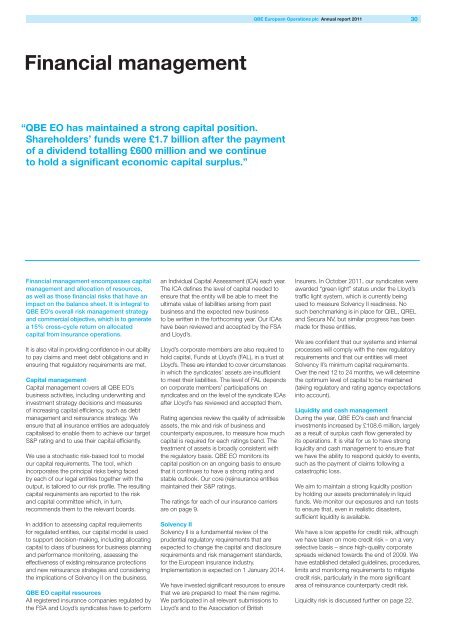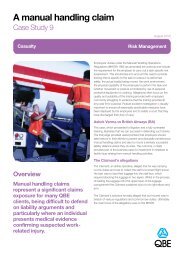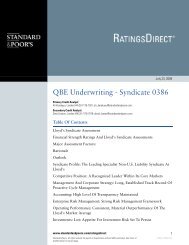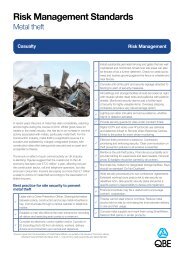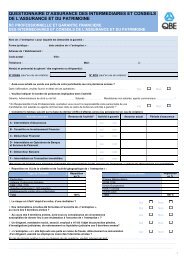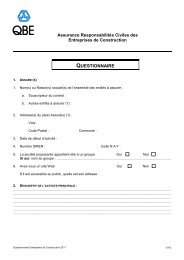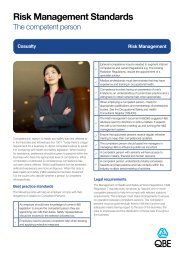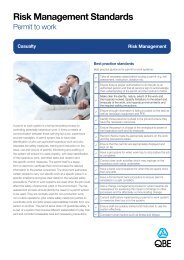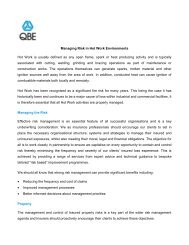QBE European Operations plc
QBE European Operations plc
QBE European Operations plc
You also want an ePaper? Increase the reach of your titles
YUMPU automatically turns print PDFs into web optimized ePapers that Google loves.
<strong>QBE</strong> <strong>European</strong> <strong>Operations</strong> <strong>plc</strong> Annual report 2011 30<br />
Financial management<br />
“<strong>QBE</strong> EO has maintained a strong capital position.<br />
Shareholders’ funds were £1.7 billion after the payment<br />
of a dividend totalling £600 million and we continue<br />
to hold a significant economic capital surplus.”<br />
Financial management encompasses capital<br />
management and allocation of resources,<br />
as well as those financial risks that have an<br />
impact on the balance sheet. It is integral to<br />
<strong>QBE</strong> EO’s overall risk management strategy<br />
and commercial objective, which is to generate<br />
a 15% cross-cycle return on allocated<br />
capital from insurance operations.<br />
It is also vital in providing confidence in our ability<br />
to pay claims and meet debt obligations and in<br />
ensuring that regulatory requirements are met.<br />
Capital management<br />
Capital management covers all <strong>QBE</strong> EO’s<br />
business activities, including underwriting and<br />
investment strategy decisions and measures<br />
of increasing capital efficiency, such as debt<br />
management and reinsurance strategy. We<br />
ensure that all insurance entities are adequately<br />
capitalised to enable them to achieve our target<br />
S&P rating and to use their capital efficiently.<br />
We use a stochastic risk-based tool to model<br />
our capital requirements. The tool, which<br />
incorporates the principal risks being faced<br />
by each of our legal entities together with the<br />
output, is tailored to our risk profile. The resulting<br />
capital requirements are reported to the risk<br />
and capital committee which, in turn,<br />
recommends them to the relevant boards.<br />
In addition to assessing capital requirements<br />
for regulated entities, our capital model is used<br />
to support decision-making, including allocating<br />
capital to class of business for business planning<br />
and performance monitoring, assessing the<br />
effectiveness of existing reinsurance protections<br />
and new reinsurance strategies and considering<br />
the implications of Solvency II on the business.<br />
<strong>QBE</strong> EO capital resources<br />
All registered insurance companies regulated by<br />
the FSA and Lloyd’s syndicates have to perform<br />
an Individual Capital Assessment (ICA) each year.<br />
The ICA defines the level of capital needed to<br />
ensure that the entity will be able to meet the<br />
ultimate value of liabilities arising from past<br />
business and the expected new business<br />
to be written in the forthcoming year. Our ICAs<br />
have been reviewed and accepted by the FSA<br />
and Lloyd’s.<br />
Lloyd’s corporate members are also required to<br />
hold capital, Funds at Lloyd’s (FAL), in a trust at<br />
Lloyd’s. These are intended to cover circumstances<br />
in which the syndicates’ assets are insufficient<br />
to meet their liabilities. The level of FAL depends<br />
on corporate members’ participations on<br />
syndicates and on the level of the syndicate ICAs<br />
after Lloyd’s has reviewed and accepted them.<br />
Rating agencies review the quality of admissible<br />
assets, the mix and risk of business and<br />
counterparty exposures, to measure how much<br />
capital is required for each ratings band. The<br />
treatment of assets is broadly consistent with<br />
the regulatory basis. <strong>QBE</strong> EO monitors its<br />
capital position on an ongoing basis to ensure<br />
that it continues to have a strong rating and<br />
stable outlook. Our core (re)insurance entities<br />
maintained their S&P ratings.<br />
The ratings for each of our insurance carriers<br />
are on page 9.<br />
Solvency II<br />
Solvency II is a fundamental review of the<br />
prudential regulatory requirements that are<br />
expected to change the capital and disclosure<br />
requirements and risk management standards,<br />
for the <strong>European</strong> insurance industry.<br />
Implementation is expected on 1 January 2014.<br />
We have invested significant resources to ensure<br />
that we are prepared to meet the new regime.<br />
We participated in all relevant submissions to<br />
Lloyd’s and to the Association of British<br />
Insurers. In October 2011, our syndicates were<br />
awarded “green light” status under the Lloyd’s<br />
traffic light system, which is currently being<br />
used to measure Solvency II readiness. No<br />
such benchmarking is in place for QIEL, QREL<br />
and Secura NV, but similar progress has been<br />
made for these entities.<br />
We are confident that our systems and internal<br />
processes will comply with the new regulatory<br />
requirements and that our entities will meet<br />
Solvency II’s minimum capital requirements.<br />
Over the next 12 to 24 months, we will determine<br />
the optimum level of capital to be maintained<br />
(taking regulatory and rating agency expectations<br />
into account).<br />
Liquidity and cash management<br />
During the year, <strong>QBE</strong> EO’s cash and financial<br />
investments increased by £108.6 million, largely<br />
as a result of surplus cash flow generated by<br />
its operations. It is vital for us to have strong<br />
liquidity and cash management to ensure that<br />
we have the ability to respond quickly to events,<br />
such as the payment of claims following a<br />
catastrophic loss.<br />
We aim to maintain a strong liquidity position<br />
by holding our assets predominately in liquid<br />
funds. We monitor our exposures and run tests<br />
to ensure that, even in realistic disasters,<br />
sufficient liquidity is available.<br />
We have a low appetite for credit risk, although<br />
we have taken on more credit risk – on a very<br />
selective basis – since high-quality corporate<br />
spreads widened towards the end of 2009. We<br />
have established detailed guidelines, procedures,<br />
limits and monitoring requirements to mitigate<br />
credit risk, particularly in the more significant<br />
area of reinsurance counterparty credit risk.<br />
Liquidity risk is discussed further on page 22.


